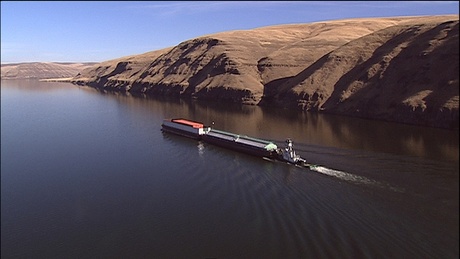forum
library
tutorial
contact

Dredging Plan for Lower Snake
Stirs Up Opinions
by Aaron Kunz
Boise State Public Radio, April 8, 2013
|
the film forum library tutorial contact |

|
Dredging Plan for Lower Snake
by Aaron Kunz
|
 The U.S. Army Corps of Engineers is developing a plan to dredge a deeper shipping channel behind southeastern Washington's Lower Granite Dam.
The U.S. Army Corps of Engineers is developing a plan to dredge a deeper shipping channel behind southeastern Washington's Lower Granite Dam.
Idaho's Port of Lewiston say the work is important to keep the local economy moving. But some environmental groups are opposed to the plan's effects on salmon; others worry about the cost to taxpayers.
The Corps of Engineers' plan would deploy heavy machinery to dig up and remove sediment collecting on the bottom of the dam-created Lower Granite Lake, where the depth is as shallow as seven feet. The corps wants to create a shipping channel that's 14-feet-deep and 250-feet wide.
Each year the Snake River delivers more than a million cubic yards of silt. Much of it settles about 20 miles above the Lower Granite Dam, near Lewiston.
Dredging has for years been the Corps of Engineers' preferred method to keep ahead of this consequence of dam-building: shallow channels that can strand barges and rising waters that could flood Lewiston. The last time this section was dredged was 2006.
Bruce Henrickson, a spokesman for the corps, says dredging is one of several tools intended for use over the next ten years. But in sections along the Snake River where it's too shallow, the only short-term solution they are considering is dredging.
"Right now there is an immediate need action trigger that we've reached and the only proven effective short term solution we've identified is the dredging," Henrickson says.
The corps intends to dredge about 114 acres, amounting to 1 percent of the the reservoir impounded behind Lower Granite Dam.
The Army Corps needs $39 million from Congress and has to meet environmental requirements before it can start work. The latest effort to dredge is generating mixed reaction.
Idaho Rivers United based in Boise is against dredging. Kevin Lewis says digging up the river bottom creates plumes of silt and sediment that endanger to fish and other species. Dredging could also stir up other pollutants that have settled on the river bottom over many years.
"The collateral damage of barging is the decimation of our native salmon and steelhead species," says Lewis. He says it's time for the corps to stop dredging its way out of problems created by the dams on the lower Snake River. Instead, more grain and other goods should be shipped by trains and trucks.
"Dredging to maintain what we see as an obsolete form of transport, a barging system on the river, is really an endless task," Lewis says. "They'll have to be dredging forever and we don't think that's really sustainable."
Henrickson with the U.S. Army Corps of Engineers says barging has an environmental edge over other transportation modes.
"I can tell you that barging is an efficient, and less polluting way to transport cargo," says Henrickson, adding that a single barge carries as much freight as 35 rail cars or 100 trucks on the highway -- but moving that barge requires less fuel and emits less pollution.
The corps does not intend to raise the levees in Lewiston, Idaho as part of this plan. Public comment on the corps water quality plan will end April 11. You can read more about the water quality plan here. Submit your comments to ecyrefedpermits@ecy.wa.gov.
(bluefish notes: ACOE's suggestion that barging "requires less fuel" is unsubstantiated. Discussion with Bruce Henrickson confirms that this statement neglects the energy that lock flushes use up and that barge operators do not pay for -- about $1 million per year on the Lower Snake River. See also Relate Page below).Related Pages:
learn more on topics covered in the film
see the video
read the script
learn the songs
discussion forum
